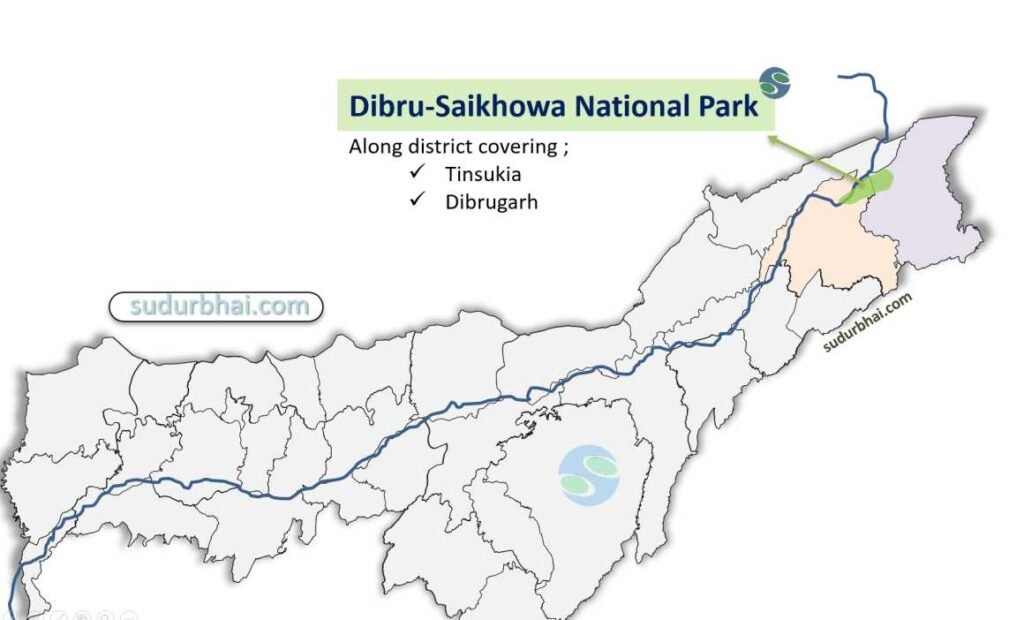Dibru-Saikhowa National Park

1. Location and Area of Dibru-Saikhowa National Park
- Geographical Location: Situated in eastern Assam, along the southern banks of the Brahmaputra River.
Districts Covered: Tinsukia and Dibrugarh
Total Area: 340 sq. km
Landscape Features:
Located in the Brahmaputra floodplains.
Consists of swamp forests, grasslands, wetlands, and riverine islands.
Famous for its ever-changing riverine ecosystem and numerous river channels.

2. Year of Establishment of Dibru-Saikhowa National Park
- Declared as a Wildlife Sanctuary: 1986.
Declared as a National Park: 1999.
Declared as a Biosphere Reserve: 1997 (one of the four Biosphere Reserves in Assam).
3. Biodiversity of Dibru-Saikhowa National Park
A. Flora of Dibru-Saikhowa National Park
- Vegetation Types:
Tropical Moist Deciduous Forests.
Semi-Evergreen Forests.
Swamp Forests and Grasslands.
Riverine and Wetland Vegetation.
Dominant Plant Species:
Trees: Sal, Sissoo, Hollong, Simul, Kumbhi, and Bamboo.
Aquatic Plants: Water hyacinth, sedges, and floating ferns in wetland areas.
B. Fauna of Dibru-Saikhowa National Park
- Mammals
Key Species:
Feral Horses (Descendants of horses left behind by British Army, unique to the park).
Bengal Tiger, Indian Leopard (Top predators).
Gangetic River Dolphin (Endangered freshwater species, found in the Brahmaputra and Dibru Rivers).
Hoolock Gibbons (India’s only ape species, found in forested areas).
Asiatic Elephant, Wild Buffalo, Sloth Bear, and Golden Langur.
Avifauna (Birdlife – Important Bird Area by BirdLife International)
Over 350+ bird species recorded.
Key Bird Species:
White-winged Duck (State Bird of Assam, critically endangered).
Black-breasted Parrotbill, Bengal Florican (critically endangered).
Greater Adjutant Stork, Lesser Adjutant Stork.
Migratory Birds: Bar-headed Goose, Ruddy Shelduck, and White-tailed Eagle.
Reptiles & Amphibians
Indian Python, King Cobra, Monitor Lizard, and Turtles.
- Mammals
4. Major Rivers and Terrain of Dibru-Saikhowa National Park
A. Major Rivers of Dibru-Saikhowa National Park
Brahmaputra River: Forms the northern boundary of the park.
Dibru River & Saikhowa River: Tributaries that create multiple riverine islands inside the park.
Lohit River: Influences the park’s floodplain ecosystem.
B. Terrain & Climate of Dibru-Saikhowa National Park
Landscape:
Dynamic riverine floodplain ecosystem.
Frequent course changes of rivers leading to the formation of islands and wetlands.
Climate:
Humid subtropical climate with high rainfall.
Annual Rainfall: 2300-3800 mm (Heavy monsoonal floods).
Temperatures: Summers (24-34°C), Winters (7-16°C).
5. Conservation Challenges and Successes in Dibru-Saikhowa National Park
A. Conservation Challenges
Human Encroachment and Illegal Settlements
Increasing human activities along the park’s periphery threaten its biodiversity.
Farming, fishing, and sand mining are rising concerns.
Flooding and Riverbank Erosion
The Brahmaputra’s shifting course results in loss of habitat.
Annual monsoon floods impact both wildlife and park infrastructure.
Poaching and Illegal Logging
Illegal hunting of river dolphins, turtles, and wild buffalo.
Deforestation reduces the habitat of many bird species.
Oil Exploration Threats
The nearby Baghjan oil fields pose a significant risk due to oil leaks and accidental fires.
The 2020 Baghjan Oil Blowout caused severe environmental damage.
B. Conservation Successes
Increased Protection of Feral Horses
The population of feral horses has been successfully conserved despite poaching threats.
Expansion of the Biosphere Reserve
Government efforts have increased the area under protection.
Gangetic Dolphin Conservation Initiatives
Strict anti-poaching measures have helped stabilize dolphin populations.
Successful Bird Conservation Programs
Protection of White-winged Ducks and Bengal Florican has been strengthened.
6. Eco-Tourism and Adventure Activities in Dibru-Saikhowa National Park
Boat Safari on Brahmaputra and Dibru Rivers: Ideal for spotting river dolphins, migratory birds, and riverine landscapes.
Birdwatching Tours: Dibru-Saikhowa is a paradise for birdwatchers.
Jungle Trekking and Nature Walks: Exploring the diverse terrain, forests, and wetlands.
Camping on River Islands: Unique experience due to the park’s ever-changing landscape.
